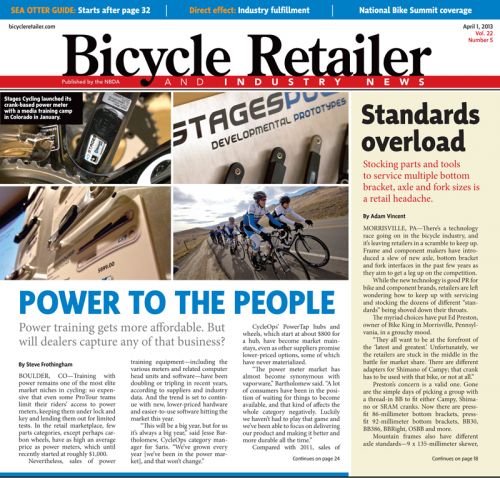By Adam Vincent
MORRISVILLE, PA—There’s a technology race going on in the bicycle industry, and it’s leaving retailers in a scramble to keep up. Frame and component makers have introduced a slew of new axle, bottom bracket and fork interfaces in the past few years as they aim to get a leg up on the competition.
While the new technology is good PR for bike and component brands, retailers are left wondering how to keep up with servicing and stocking the dozens of different “standards” being shoved down their throats.
The myriad choices have put Ed Preston, owner of Bike King in Morrisville, Pennsylvania, in a grouchy mood.
“They all want to be at the forefront of the ‘latest and greatest.’ Unfortunately, we the retailers are stuck in the middle in the battle for market share. There are different adapters for Shimano of Campy; that crank has to be used with that bike, or not at all.”
Preston’s concern is a valid one. Gone are the simple days of picking a group with a thread-in BB to fit either Campy, Shimano or SRAM cranks. Now there are press-fit 86-millimeter bottom brackets, press-fit 92-millimeter bottom brackets, BB30, BB386, BBRight, OSBB and more.
Mountain frames also have different axle standards—9 x 135-millimeter skewer, 10 x 135-millimeter skewer and 12 x 142-millimeter threaded skewer.
The biggest problem with all of the competing standards is the seemingly insurmountable challenge when it comes to stocking all the compatible parts and tools to work on them.
“Our lives would be easier if the industry could collectively decide on standards,” said Chris Padavana, owner of Eden Bicycles in Castro Valley, California. “This would help us with inventory control, increasing our bottom line.”
Preston points out that the increased SKU count adds to his inventory costs. He also has to invest in new tools to install and maintain the parts.
“With margins thinning every year, it is one more thing you have to juggle,” he said. “You have to figure out where those five points you lost are going to be regained.”
Most retailers don’t stock all the parts necessary to keep up in the technology race and are stuck playing the “we can order that for you” game. The scenario is a common one for retailers. And while they can get the parts quickly, often the sale is lost once the customer walks out the door.
“Most of the bikes we carry have a lot of the same standards,” said Brent Forrer, service manager at Spin Bike Shop in Lakewood, Ohio. “But if we have to order something we can. We order twice a week from QBP, so we can get parts in a day or two.”
Forrer remains upbeat about the diversity of parts, however.
“It’s up to us as retailers to know about the compatibility issues and advise the customer accordingly. As long as we really know what they need, the customer doesn’t need to worry about those details. As soon as you explain the benefits to the customer, they usually get on board. It goes back to the sales and service teams staying informed.”
Eden Bicycles’ mechanics spend a fair amount of time researching and training on the new components. “They have to spend more time investigating and that is time we can’t factor into our pricing of a repair job. It’s money lost,” Padavana said.
Preston has seen it all with decades on the job. “It is becoming more and more difficult. We have gone through 15 different new BB standards in the last 10 years, all in the name of ‘industry standard.’ The funny part is, we still have no standard. And it is tough to embrace something you know is going to change in the next model year. Sometimes I long for the simple square-taper spindle,” Preston said.
And the speed of technological change only continues to increase. Manufacturers will always look for the latest and greatest to keep their product lines fresh in the minds of consumers. Retailers will continue to adapt, though perhaps begrudgingly.
“The excitement of new and innovative products being introduced is great. I got into this business because I love bikes. But from a business perspective, it’s a challenge to keep everything straight with new products plus the current inventory on hand. It’s getting harder and harder to keep the bottom line positive and keep the brick-and-mortar retailer looking good in the eyes of the consumer,” Padavana said.


